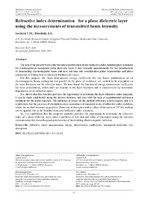Refractive index determination for a plane dielectric layer using the measurements of transmitted beam intensity

Date
2017Publisher
Another Title
Определение показателя преломления плоского диэлектрического слоя методом измерения интенсивностей проходящих пучков
Bibliographic entry
Serdyuk, V. M., Titovitsky J. A. Refractive index determination for a plane dielectric layer using the measurements of transmitted beam intensity = Определение показателя преломления плоского диэлектрического слоя методом измерения интенсивностей проходящих пучков / V. M. Serdyuk, J. A. Titovitsky // Приборы и методы измерений : научно-технический журнал. - 2017. – Т. 8, № 1. – С. 55 - 60.
Abstract
The aim of the present work is the theoretical justification of new refractive index determination technique for a homogeneous transparent plane dielectric layer. It uses intensity measurements for two polarizations of transmitting electromagnetic beam and does not take into consideration phase relationships and phase parameters of testing field at unknown thickness of a layer. For this purpose, the layer transmission energy coefficients for two linear polarizations of an electromagnetic beam, orthogonal and parallel to the plane of incidence, are studied to be dependent on the layer thickness and its refractive index. We have found the function of energy transmission coefficients for these polarizations, which does not depend on the layer thickness and is characterized by monotonic dependence on its refractive index. It is shown that this function provides the opportunity to determine the layer refractive index uniquely. It can be made analytically using the inverse function, and also with the help of experimental calibration technique for the initial function. The influence of losses on the method efficiency is investigated, and it is established, that the presence of absorption causes appearance of separated zones of refractive index variation, where the method becomes inoperative. However, at absorption index values of the order of 10–5 the method can be applied, but in the bounded domain of refractive index variation. So, it is established that the proposed methods provides the opportunity to determine the refractive index of a plane dielectric layer under conditions of low and null value of absorption using the intensity measurements for two orthogonal polarizations of transmitting electromagnetic radiation.
Abstract in another language
Целью работы является теоретическое обоснование нового метода определения показателя преломления однородного прозрачного плоского диэлектрического слоя по измерению интенсивности двух поляризаций проходящего пучка электромагнитного излучения без учета фазовых соотношений и фазовых параметров тестирующего поля при неизвестной толщине слоя. Для этого рассматривались энергетические коэффициенты прохождения слоя для двух линейных поляризаций пучка электромагнитного излучения, перпендикулярной и параллельной плоскости падения, и изучались их зависимости от показателя преломления слоя и его толщины. Найдена функция энергетических коэффициентов прохождения двух разных поляризаций, которая не зависит от толщины слоя и характеризуется монотонной зависимостью от его показателя преломления. Показано, что применение данной функции позволяет однозначно определить искомый показатель
преломления слоя по измерениям интенсивностей двух ортогональных поляризаций проходящего излучения. Это можно сделать аналитически, используя обратную функцию, а также с помощью экспериментальной калибровки исходной функции. Изучено влияние поглощения на эффективность применения метода и установлено, что его присутствие вызывает появление отдельных зон изменения
показателя преломления, где метод перестает работать. Однако если его величина не превышает значений порядка 10–5, то метод может применяться, но уже в ограниченном интервале изменения показателя преломления. Таким образом, доказано, что предлагаемый метод дает возможность определять показатель преломления диэлектрического слоя в условиях малого и нулевого поглощения по измерениям
интенсивностей проходящего электромагнитного излучения двух ортогональных поляризаций.
View/
Collections
- Т. 8, № 1[10]
